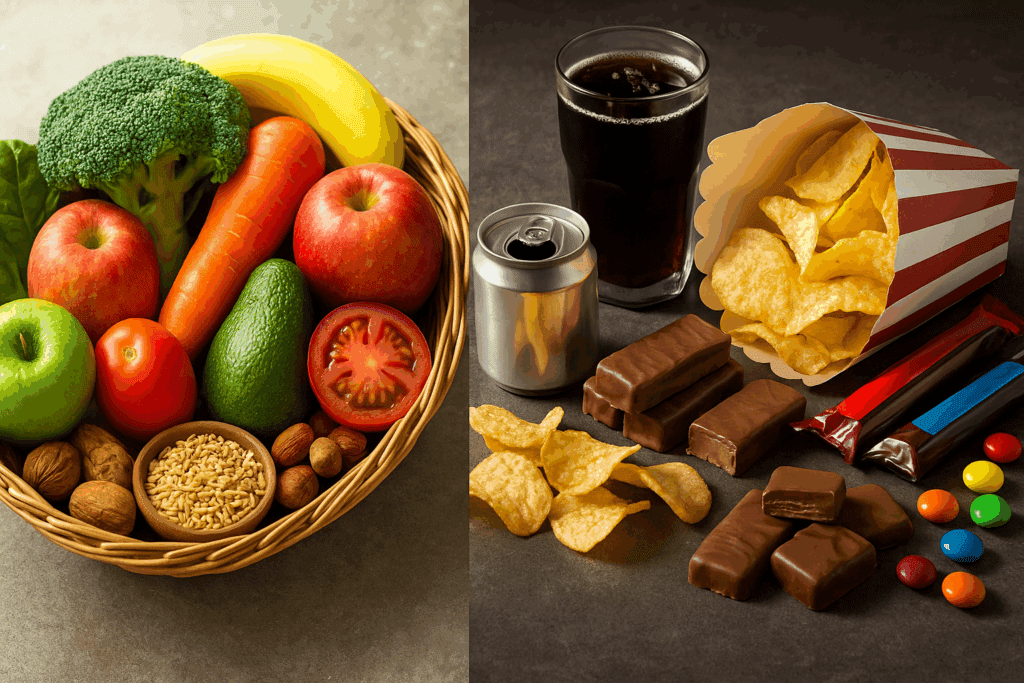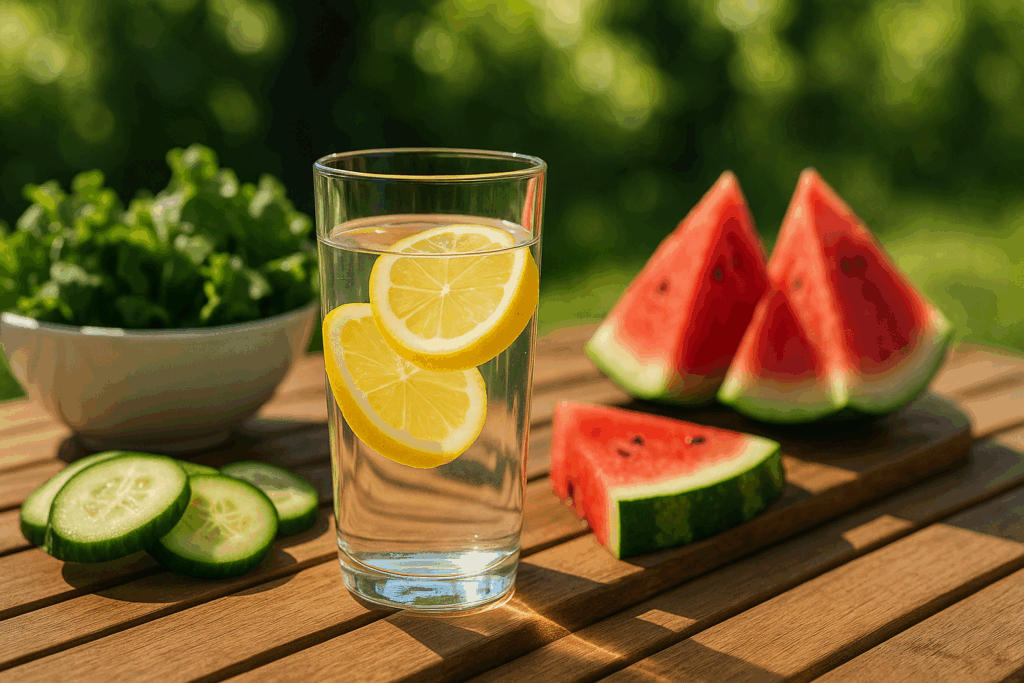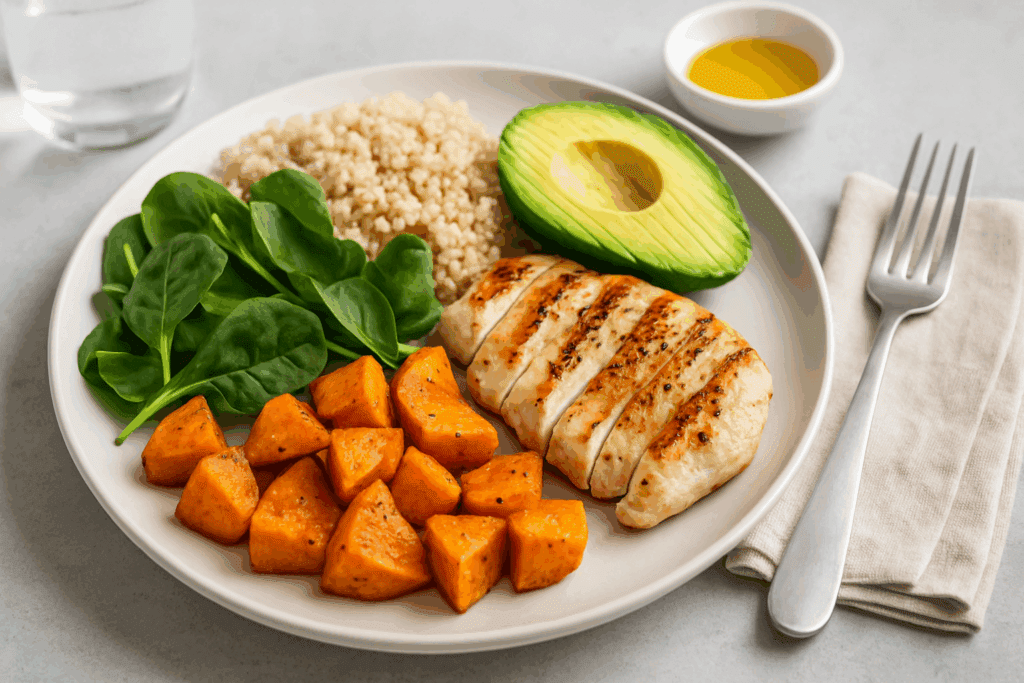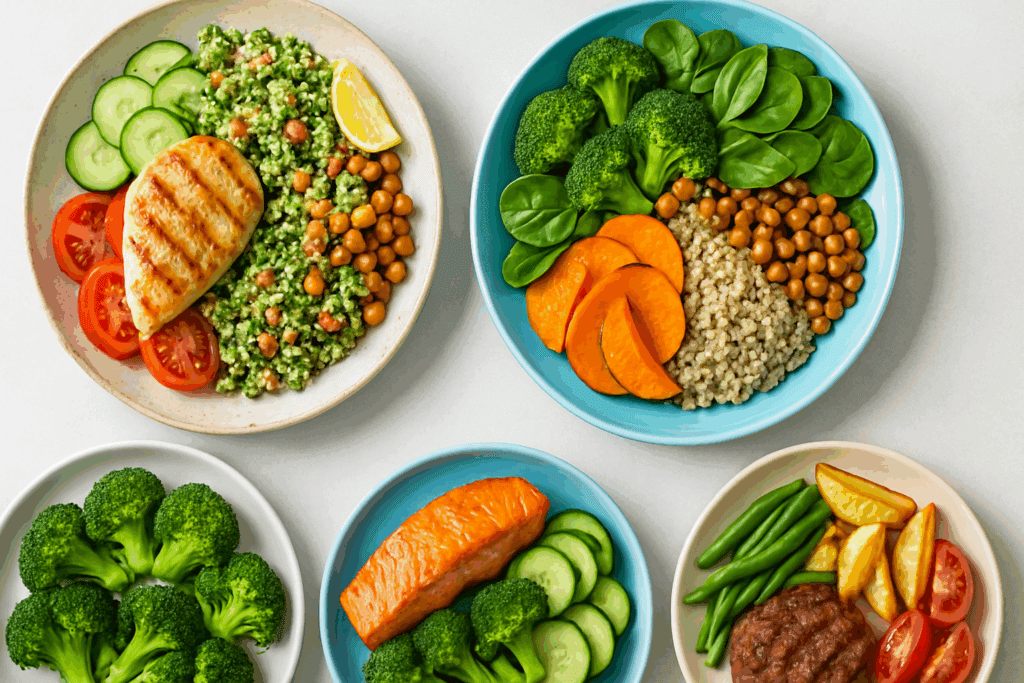In today’s fast-paced world, navigating the endless maze of nutrition advice can feel overwhelming. What does a healthy diet look like? How can we consistently choose healthy foods to eat every day when time, convenience, and stress all conspire against our best intentions? The truth is, eating right starts with good food—and good information. Developing healthy eating habits doesn’t require a dramatic overhaul of your lifestyle. Instead, it means making smart, science-backed choices day after day that align with your health goals and support your overall well-being.
You may also like: The Best Foods to Eat for a Heart-Healthy Diet: Expert-Backed Choices for Cardiovascular Wellness
A healthy diet isn’t a rigid prescription or a passing trend—it’s a sustainable pattern of eating that delivers essential nutrients, supports mental clarity, bolsters immune function, and reduces the risk of chronic disease. And while the healthiest foods might vary slightly depending on individual needs, there are core principles of nutritious food intake that stand the test of time and scientific scrutiny. Whether you’re wondering how to eat better, seeking the best foods to eat on a diet, or simply asking, “What are foods that are good for you?”—this article will guide you through four transformative yet practical strategies to help you build a healthy diet from the inside out.
Let’s explore how to eat healthy with expert insights that go beyond calorie counting, helping you achieve long-term wellness without sacrificing joy at the table.
Prioritize Whole, Nutrient-Dense Foods Over Processed Options
One of the cornerstones of a healthy diet is consistently choosing whole, minimally processed foods that are naturally rich in nutrients. These are the healthiest foods to eat because they offer the most concentrated sources of vitamins, minerals, fiber, and phytochemicals. Unlike processed foods that are often stripped of their original nutrition and loaded with added sugars, sodium, and unhealthy fats, whole foods are packed with the essential building blocks your body needs for optimal function.
Whole vegetables, fruits, legumes, nuts, seeds, whole grains, lean proteins, and healthy fats are all excellent diet foods because they support metabolic health, stabilize blood sugar, and promote satiety. Studies show that diets high in whole plant-based foods are associated with lower rates of cardiovascular disease, type 2 diabetes, and certain cancers. Additionally, these foods contribute to gut microbiome diversity—a key factor in immune resilience and even mood regulation.
Consider, for example, replacing white bread with a sprouted whole grain alternative, or swapping sugar-laden breakfast cereals with steel-cut oats topped with berries and flaxseeds. These small substitutions significantly enhance your intake of healthy food options and gradually shape what is considered a proper diet for your body. When asking “what is a good diet,” one of the most accurate answers is one that’s rich in whole foods and low in ultra-processed items.
Importantly, focusing on whole foods also improves dietary satisfaction. The natural flavors, textures, and colors of fresh produce and thoughtfully prepared meals enhance the pleasure of eating. And when you enjoy what you’re eating, sustaining good nutrition habits becomes significantly easier. So if you’re still wondering “how can I eat healthy without feeling restricted?”—start with the simple act of choosing food in its most natural form.

Build Balanced Meals That Support Long-Term Energy and Fullness
Understanding what does a balanced diet look like is essential for constructing meals that nourish your body consistently. A balanced meal includes a mix of macronutrients—protein, carbohydrates, and fats—as well as fiber and water content, all of which work synergistically to support energy levels, satiety, and metabolic balance.
Protein is especially important because it’s involved in nearly every bodily function, from muscle repair to hormone regulation. Including lean proteins such as eggs, chicken, fish, legumes, tofu, and low-fat dairy in each meal supports muscle maintenance and helps you feel full longer. When paired with high-fiber carbohydrates—like quinoa, lentils, and sweet potatoes—protein slows digestion and reduces post-meal blood sugar spikes. This is a powerful combination for those seeking to maintain a healthy diet while managing weight or blood glucose.
Healthy fats, found in foods like avocado, olive oil, nuts, and seeds, should not be feared. In fact, they are among the healthiest foods to eat daily because they support brain health, aid in the absorption of fat-soluble vitamins, and enhance flavor and satisfaction. A drizzle of extra virgin olive oil on a salad or a handful of walnuts added to oatmeal is an effortless way to incorporate healthy fats into your meals without excess calories.
Fiber-rich vegetables and fruits complete the picture. They not only add volume and texture to meals but also promote digestive health and reduce the risk of chronic disease. If you’re asking, “what are the best foods to eat on a diet?” look no further than the ones that provide high nutrient density and sustained energy release.
Over time, eating this way becomes intuitive. You begin to recognize the signs of what is normal diet behavior—feeling comfortably full, not sluggish or bloated; having steady energy without crashes; and being attuned to your body’s hunger cues. These are the foundations of a good eating routine rooted in balance and mindfulness.

Cultivate Consistent, Mindful Eating Habits for Long-Term Success
It’s not just what you eat that matters—it’s how and when you eat. Developing mindful and consistent eating patterns is a vital but often overlooked aspect of building a healthy diet. When considering good nutrition habits, many people focus exclusively on food quality without examining the behaviors surrounding their meals. Yet behavioral patterns strongly influence metabolic outcomes, appetite regulation, and emotional well-being.
One of the most effective healthy eating tips is to eat slowly and with attention. This allows your brain time to receive satiety signals from your stomach, reducing the likelihood of overeating. Mindful eating also cultivates a more respectful and intuitive relationship with food, helping you tune into your body’s actual hunger cues rather than eating out of stress or habit.
Regular meal timing is another important factor in establishing a healthy eating routine. Irregular eating patterns—such as skipping breakfast or eating most calories late at night—can disrupt circadian rhythms and impair metabolic processes. Aim to eat meals at consistent intervals throughout the day, balancing each with a mix of protein, fiber, and healthy fats. This kind of structured eating supports stable blood sugar, better digestion, and improved mental focus.
Emotional awareness is also critical. Many people struggle with situational healthy eating—meaning their nutrition choices fluctuate based on mood, social settings, or stress levels. Developing strategies to cope with emotional triggers—such as going for a walk, calling a friend, or journaling—can help reinforce long-term healthy food choices and reduce reliance on food as emotional comfort.
If you’re asking “what is the healthiest thing to eat overall health?”—a compelling case can be made for not just any one food, but the daily practice of consistent, conscious eating. This approach integrates both nourishment and self-awareness into your wellness journey, making it easier to stick with nutritious food choices for the long haul.

Stay Hydrated and Use Hydration to Support Appetite Regulation and Digestion
While often overlooked in conversations about diet food and healthy food options, hydration plays a pivotal role in supporting overall nutrition. Water is essential for virtually every physiological process, including digestion, nutrient absorption, circulation, temperature regulation, and cellular detoxification. Ensuring adequate fluid intake enhances your body’s ability to process the healthiest foods you consume and supports your ability to maintain a healthy diet in the long run.
Mild dehydration can often masquerade as hunger, leading to unnecessary snacking or overeating. By drinking water regularly throughout the day—especially before meals—you can improve satiety and better differentiate between thirst and true hunger. This practice is a simple but powerful tactic for those trying to lose weight or stick to a good eating plan.
Additionally, optimal hydration supports healthy bowel movements and prevents constipation, which is a common issue when people shift to higher fiber diets. Fiber and water work synergistically: without enough fluids, the benefits of fiber-rich healthy foods to eat every day can be diminished. Think of hydration as the unsung hero of good nutrition habits—essential, reliable, and completely free.
Beyond plain water, herbal teas, sparkling water without additives, and water-rich foods like cucumbers, melons, and leafy greens all contribute to your hydration needs. While sugary drinks and sodas might seem hydrating, they undermine health goals by adding empty calories and promoting blood sugar fluctuations. Choosing beverages wisely is part of answering the question: how to eat better and support total wellness?
In sum, hydration supports not just the digestion and absorption of healthy food, but also helps regulate appetite and improve energy levels. In the broader context of healthy eating habits, drinking enough water is one of the simplest and most impactful things you can do to reinforce your nutrition goals.

The Power of Personalization: What Is the Best Healthy Diet for You?
While the fundamentals of health and healthy eating apply broadly, it’s important to recognize that no single diet works universally for everyone. What does a healthy diet look like can vary based on age, activity level, medical history, cultural preferences, and personal goals. One person may thrive on a Mediterranean-style diet rich in olive oil and fish, while another may feel their best with a plant-based approach centered on legumes and leafy greens.
Personalized nutrition is a growing field that acknowledges the role of genetics, microbiome diversity, and lifestyle factors in shaping dietary needs. Even foods considered the healthiest to eat may not work well for every individual. For example, some people may feel bloated after eating cruciferous vegetables like broccoli or cabbage, while others digest them with ease. Likewise, the best foods to eat on a diet for someone managing insulin resistance may look different from someone recovering from gastrointestinal issues.
Working with a registered dietitian or healthcare provider can help you fine-tune your diet to your individual needs. They can help assess nutrient deficiencies, guide food choices, and develop strategies that align with your health goals. This type of expert support is especially valuable for those wondering “what is normal diet behavior for my condition?” or “how can I eat healthy with my specific diagnosis?”
What unites all effective nutrition strategies, however, is the emphasis on nutrient-rich, whole foods, balanced meals, hydration, and consistency. These are the anchors of a good eating pattern, regardless of whether you’re following a low-carb, Mediterranean, or flexitarian approach. So when considering what foods are nutritious and healthy, think in terms of patterns, not perfection.

Frequently Asked Questions: 4 Ways to Have a Healthy Diet
1. How can I maintain a healthy diet when dining out or traveling frequently?
Maintaining a healthy diet while on the go requires a mix of preparation, mindfulness, and flexibility. When dining out, scan the menu for healthy food options like grilled proteins, steamed vegetables, and dishes prepared without excessive oils or creamy sauces. Ask for dressings and sauces on the side to better control portions. If you travel often, consider packing nutrient-dense snacks such as raw almonds, dried fruit without added sugar, or whole grain crackers. Understanding what foods are nutritious and healthy in various cuisines helps you make balanced choices even when far from home. Practicing situation healthy eating in this way helps keep you on track without feeling deprived.
2. What are overlooked signs that my diet may not be as healthy as I think?
Even if you’re eating foods generally labeled as healthy, subtle signs may indicate imbalances. Frequent fatigue, irritability, brittle nails, or poor digestion can reveal nutrient deficiencies, even with a diet full of whole foods. This is why even the healthiest foods need to be consumed in appropriate combinations and quantities. For example, iron absorption improves with vitamin C-rich foods but may be inhibited by excessive coffee or tea. Good nutrition habits involve not only choosing healthy foods to eat daily but also ensuring variety and synergy in your meals. Listening to your body’s cues and monitoring energy levels are critical tools in evaluating what is a good diet for your specific needs.
3. How do I balance eating healthy with social events and cultural traditions?
Navigating social events while adhering to a healthy diet can feel like a tightrope walk, but it’s entirely possible with planning and flexibility. One helpful strategy is to eat a small nutritious food item before attending, so you’re not arriving overly hungry. Once there, choose excellent diet foods from the available options—such as fresh salads, lean proteins, and roasted vegetables—before reaching for more indulgent fare. In culturally rich settings, appreciate traditional dishes while practicing portion control and savoring each bite mindfully. Healthy eating habits should not exclude social and cultural experiences but should instead find a middle path that includes celebration and health.
4. How can I improve my children’s eating habits without creating resistance?
Cultivating healthy eating habits in children involves modeling good behavior and gradually shaping their food preferences. Instead of labeling foods as “good” or “bad,” encourage curiosity and participation—let kids help pick out vegetables at the store or assist in meal prep. Serve healthy foods to eat everyday alongside familiar favorites to normalize their presence on the plate. Keep introducing the same healthy food multiple times in different preparations—children often need multiple exposures before developing a taste for new things. Using positive reinforcement and creating a pressure-free environment helps children understand what foods are nutritious and healthy without food becoming a source of conflict.
5. What are emerging trends in nutrition that support a healthy diet?
One exciting development in nutrition is the growing field of personalized eating plans based on genetic, metabolic, and microbiome data. These insights help tailor what is best healthy diet for individual physiology rather than relying on generalized guidelines. Other trends include the use of technology like macro-tracking apps and AI meal planning, which allow users to meet nutrient needs more precisely. Sustainability is also shaping conversations around the healthiest foods to eat, with plant-forward diets and local sourcing taking center stage. The intersection of tech, sustainability, and personalization is paving the way for more accessible and effective paths to health and healthy eating.
6. How can I avoid emotional eating while staying committed to my nutrition goals?
Emotional eating is a common barrier to sustaining good eating practices, but it’s one that can be addressed with awareness and skill-building. Start by identifying emotional triggers such as stress, boredom, or loneliness, and develop alternative coping strategies like walking, deep breathing, or talking to a friend. Keeping a journal that tracks your mood and food intake can reveal patterns you might not notice otherwise. Integrating healthy foods to eat daily into structured meals and snacks can also help prevent impulsive choices made during emotional lows. Recognizing that eating right starts with good food—but also with emotional clarity—allows for more resilient and sustainable healthy eating habits.
7. How can I assess if my current diet meets all my nutritional needs?
To ensure your diet is comprehensive, consider tracking your meals for a week and comparing your intake to established dietary guidelines or using nutrient-tracking tools. Look beyond calories and protein to assess intake of vitamins, minerals, fiber, and essential fats. Sometimes, even diets packed with healthy food can fall short in key areas like omega-3s, magnesium, or iodine. Including a wider variety of healthy foods to eat everyday helps cover more nutritional ground. If you’re unsure, a registered dietitian can evaluate your meals and recommend adjustments based on what a balanced diet looks like for your age, gender, and activity level.
8. What are the psychological benefits of adopting a healthy diet long-term?
While much of the focus on a healthy diet is physical, the psychological effects are equally compelling. A nutritious food intake pattern rich in antioxidants, healthy fats, and fiber has been associated with reduced symptoms of depression and anxiety. Consistently choosing healthy food options can foster a sense of control and self-efficacy, improving overall life satisfaction. Over time, reinforcing healthy eating tips with tangible outcomes—such as more stable moods, improved focus, and restful sleep—makes good nutrition habits feel worthwhile and motivating. In essence, the connection between food and mood is a powerful motivator for maintaining what is a proper diet for mental and emotional resilience.
9. Can healthy eating be affordable on a tight budget?
Absolutely. While some of the healthiest foods can come with a higher price tag, good eating is still very possible with strategic planning. Staples like beans, lentils, oats, eggs, and frozen vegetables offer high nutritional value for minimal cost. Buying in bulk, meal prepping, and shopping for in-season produce are all tactics that align with both budget constraints and health and healthy eating. Understanding what are food that are good for you doesn’t mean breaking the bank—it often means choosing simple, wholesome ingredients over processed, packaged alternatives. Learning how to eat better is also about learning how to shop smarter.
10. How do I transition from a restrictive diet mindset to a more sustainable healthy eating approach?
Shifting from a restrictive mindset to sustainable healthy eating involves redefining your relationship with food from one of control to one of nourishment. Focus on adding healthy foods to eat daily rather than subtracting so-called forbidden items. Explore what does a healthy diet look like through variety, satisfaction, and flexibility rather than rigid rules. A sustainable approach means including your favorite meals in moderation, appreciating meals as experiences, and tuning into your body’s needs rather than external diet food trends. In the long run, sustainable healthy food choices are those you can enjoy and maintain, not those you endure for short-term results.

Conclusion: Embracing Healthy Eating for Life—Beyond Trends and Toward Transformation
Healthy eating is not a short-term fix or a restrictive regimen. It’s a deeply empowering lifestyle grounded in knowledge, consistency, and compassion for your body. When you prioritize nutrient-dense foods, build balanced meals, eat mindfully, and stay hydrated, you’re doing far more than following a diet—you’re cultivating a way of living that honors your well-being and longevity.
If you’ve ever asked yourself “how can I eat healthy without losing the joy of food?” or “what is best healthy diet for lasting wellness?”—the answer lies in personalization, variety, and the small daily choices that add up over time. There is no singular healthiest food or one-size-fits-all solution. Instead, excellent diet foods and good nutrition habits emerge from patterns that fit into your unique life situation.
Whether you’re just starting your journey toward better health or refining an already balanced lifestyle, remember that eating right starts with good food and continues with good choices. By embracing the principles of whole food nutrition, consistency, hydration, and mindfulness, you can turn the question “what does a healthy diet look like?” into a lived experience—one that nourishes not just your body, but your entire life.
So take the first step today. Choose a colorful salad, swap your soda for water, pause before your next bite, and celebrate the transformative power of nourishing food. Because in the end, health and healthy eating are not just about what you put on your plate—they’re about how you choose to live.


